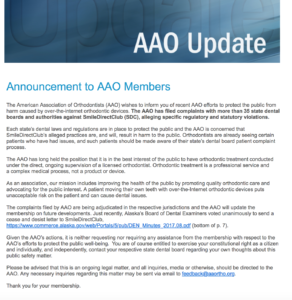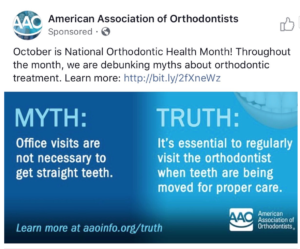The last time organized dentistry and dental boards tried to “protect the public” they warned of the dangers of tooth whitening done outside the office of a licensed dentist. Of course there was no danger and this obvious collusion among dentists in an attempt to protect their monopoly was contested by the FTC and crushed by the US Supreme Court.
Having failed to learn their lesson about putting their profits above the public good, organized dentistry and state boards are at it again. This time it’s a coordinated attack by the American Association of Orthodontists and some State Dental Boards to deny the average American citizen access to orthodontic treatment – even though the treatment is prescribed and supervised by a licensed dental professional and, more often than not, an orthodontist!
Let’s take a look at the assumptions the AAO makes in their complaints to State Dental Boards, the email to their members and in the BuzzFeed article they prompted.

Email from the AAO to AAO members

AAO Facebook ad
ASSUMPTION #1 -Orthodontists in traditional orthodontic practice (where braces and clear aligners cost 4000-8000 dollars) act like every case they have ever treated gets a perfect finish and that every patient they have ever seen is happy.
TRUTH – You don’t have to take our word for it, just search your local orthodontists on Yelp, Facebook, Google or any other site and you’ll see that no one can make everyone happy.
ASSUMPTION #2 – There has never been a complaint to a State Dental Board about a traditional orthodontist or dentist delivering orthodontic care with clear aligners.
TRUTH – Again, the public record clearly states otherwise.
ASSUMPTION #3 – Everyone can afford orthodontic treatment from a traditional orthodontic office.
TRUTH – Orthodontist have consistently refused to make braces or clear aligners affordable. By the American Association of Orthodontists’ own statistics, even though almost 80 percent of Americans could benefit from orthodontics only 3-4 million people get orthodontic treatment each year (and a good bit of that is done by general dentists). That means that you’d divide the number of people who get treatment by the US population or 3,500,000/325,000,000 to find out what percentage of the population receives care each year. That’s only 1 percent of the population! AND seeing how the US population is growing at .7 percent we assume the other 99 percent don’t deserve access to care? Apparently many orthodontists think so as expressed by the orthodontist “BH” in the comments on this blog post (you won’t believe what he said).
ASSUMPTION #4 – All orthodontists and dentists who are in traditional practice agree on when and how often they must see patients receiving clear aligner treatment.
TRUTH – Not even close. The opinions are strongly held and range from seeing patients every 4 weeks to giving patients the entire box of aligners on the first appointment and telling them to “come back when you are done and send me a photo on your phone if there is an issue”. Orthodontists have zero problem with the efficacy or utilization of teledentistry but they want to make sure they are the only ones who are paid for doing so.
ASSUMPTION #5 – State law mandates an in-person examination and X-rays.
TRUTH – There is no such requirement. Sometimes orthodontists take an x-ray and sometimes they don’t. Sometimes a patient refuses to allow an X-ray when they are being treated in a traditional orthodontic office… Guess what happens? Do you think the orthodontist allows a $5500 payday to walk out of the door on a straightforward orthodontic case because they don’t have an X-ray? Nope. This has been discussed often on the orthodontic Facebook pages. Also the AAO forgets that in their Guidelines for Radiography 2016, The British Orthodontic Society are more pragmatic/realistic than their American cousins and recognize that straightforward orthodontic treatment does not require irradiating patients:
Conclusions page 27:
There is no indication for taking or requesting radiographs when only minimal tooth movement is planned.
Last conclusion:
There is no indication for prospective radiographs only for medico-legal reasons, i.e.-the practice of defensive dentistry
ASSUMPTION #6 – SmileDirectClub providers are more motivated to proceed with treatment than traditional orthodontists.
TRUTH – There is zero difference between teledentistry and traditional delivery of orthodontics when it comes to deciding whether or not to render treatment. If an orthodontist in either model delivers care, they get paid. If not then they don’t get paid. The only difference is the volume of patients and relative amount of money – traditional orthodontists treat far fewer patients and have much more money on the line than those doing teledentistry so who do you think is more motivated to “damn the torpedoes” and start treatment?
ASSUMPTION #7 – If someone cannot afford 4000 – 8000 dollars and days off for the dozens of office visits required for “quality treatment” from an orthodontist they are better off with no treatment.
TRUTH – The vast majority of people cannot afford that kind of time or money. AAO members and most orthodontists effectively refuse to treat the overwhelming majority of Americans but they want to prevent anyone else from doing so. This is like taxi drivers refusing to service working class neighborhoods while trying to block Lyft and Uber from doing so.
ASSUMPTION #8 – Delivering orthodontics via teledentistry is bad.
TRUTH – Many orthodontists have been doing this for years.
ASSUMPTION #9 – Teledentistry “damages patients and creates traumatic bite issues”.
TRUTH – Clear aligners don’t know if they are delivered in an orthodontic office or via teledentstry. Bad treatment is bad, good treatment is good no matter where it takes place. What about the people who currently have a traumatic or socially unacceptable bite? Are the orthodontists going to treat them for free? I think not. What option are the people who are already in a bad way given if orthodontists refuse to make orthodontics accessible? Does the AAO’s position indicate a genuine concern over public safety?
ASSUMPTION #10 – SmileDirectClub does not require their patients to be under the care of a dentist who examines their teeth.
TRUTH – In addition to having a licensed dental professional prescribe and oversee their treatment, every single SmileDirectClub patient is required to acknowledge, in writing, that they are current with their general dentist and have no pending dental work, cavities or periodontal disease. The AAO and orthodontists say this is not good enough “because a patient could lie” on their health history form. But since when is a dentist supposed to act like a parent and ferret out the truthiness of what our patients tell us? Is the AAO saying that it’s impossible for a patient to lie on the health history forms they fill out in a traditional office? Is the AAO suggesting that a doctor cannot trust any information we gather from a patient? Is this North Korea??
Long story short, The American Association of Orthodontists and other organized dentistry groups along with State Dental Boards want to protect their bottom lines at all costs. This is a very old story and why the Sherman Act is in place. Dentistry is one of the few true guilds left in America and they will fight hard to maintain monopolistic control as long as they can. It will be fun to watch this play out in the courts and in the court of public opinion. Americans are smart and will see through to what is actually going on here.
Marc Ackerman DMD, MBA, FACD
Ben Burris DDS, MDS


I really enjoy some of your articles for reminding us to this outside the box when we sometimes just follow the pied piper … so to speak. You raised good points on some of the ‘myths’ that AAO ‘debunked’ as well.
However, when you so vociferously advocate SDC do you make sure to put the disclaimer that you gain financially from promoting SDC as you are one of the orthodontists they have on their team. I think AAO should be very transparent in its affairs to its members and I know you have been a voice in encouraging that however transparency from both sides is only fair to your readers.
It never ceases to amaze me that when Ben and I write a blog on any issue of significance, some reader will try to question our intent by claiming that the work is entirely motivated by financial interests. I HAVE NO FINANCIAL INTEREST IN SDC and NO ASSOCIATION WITH COMPANY OPERATIONS.
The topic of this blog is collusion by organized dentistry under the false pretense of protecting the public. We have citied the outcome of the last episode of this strategy (FTC vs. NC Dental Board) and laid out 10 false assumptions that the AAO is operating under.
Burris has told the world that he is an ELP for SDC both publicly and privately on Facebook, Orthopundit, and the Progressive Orthodontist Magazine. So rather than get mired in a discussion about Ben’s teledentistry practice, let’s try and stick to the substantive issues at hand.
Marc
On Assumption #2, there have been complaints to State Dental Boards from patients treated with clear aligners from orthodontists. There have been lawsuits filed against orthodontists who treated with clear aligners. There have been settlements paid to patients from treatment from clear aligners. There have been periodontal disease claims made against orthodontists from clear aligners.
Agreed and this assumption to the contrary is a big part of why the AAO and State board arguments against teledentistry don’t hold water. I know many of these assumptions are statements of the obvious but somehow they are not apparent to the majority of orthodontists.
Ben
Mel
I haven’t seen you since your AAO Presidency at the 2006 AAO Annual Session in Las Vegas. I believe the theme was “Bright Lights…Winning Smiles”. Memory serves me that the meeting focused on emerging technology as an aid to practice efficiency. The message to consumers that year was avoid Hollywood makeovers that used restorative dentistry rather than orthodontics due to the fact that those techniques are “non-reversible”. That would mean that most orthodontic treatments offered are reversible. I’m glad that you agree with us on assumption #2.
Marc
https://www.sesamecommunications.com/wp-content/PPNarticles/Q4-2005/reality.html
All of the complaints and lawsuits that I was referencing came from patients that were being seen and monitored by orthodontists. I have no knowledge of suits and complaints against general dentists using aligners but I am certain that they also have them. I am sure that there will be complaints to state Boards and lawsuits over teledentistry as well as that is the nature of humans treating patients in all fields of health care. I will say that most of claims comes from the orthodontist failing to monitor the patient with periodic panos. Treating patients with no knowledge of the perio, cysts, root lengths, decay present, etc.from a pano and no way of monitoring progression during treatment is not something that I would choose t do but it is not my responsibility to tell my colleagues how to practice. I get the signed form from the teledentistry patient that they have had a clearance from their dentist but for me, that would not be sufficient as yes they do lie on their medical and dental history forms frequently. They will lie for cosmetic treatment and pass on the general dentistry. I prefer to see the film and pass when treatment will do the patient harm. It is not just a matter of not being held legally responsible for me. I have also seen many judgments given for improper management of root resorption and perio disease that occurs after treatment is begun and the orthodontist fails to monitor. With teledentistry who is going to monitor for perio progression, decay, and root resorption when the patient is not seen at al?. A photo is not going to revel most of those problems. I am in Neil’s camp with hopes that a way in found for a few panos during teledentisty treatment.
Marc, thanks for the link to the 2006 meeting. It seems ages ago now but it was fun to participating the planning and put the places together for a 22,000 attended meeting. The damage that I am referring to from patient lawsuits from orthodontists is not reversible however. Teeth that are lost are lost forever. We are seeing some very rampant decay of all of the teeth that occurs in a very short time frame from patients that are drinking soft drinks and juices with their aligners in. Hope that all that read this will emphasize that the aligners should be removed before such consumption.It may be rare but crowns on the whole dentition are expensive. We have seen perio progression under aligners as well as root resorption. Of course the perio and resorption is less likely if the treatment is a year or less and tooth movement is minor.
http://www.wrdw.com/content/news/Mail-order-braces–Is-your-smile-worth-the-cost-452548583.html
https://www.google.com/amp/abcnews.go.com/amp/Business/boy-wears-braces-11-years-sues-orthodontist/story%3fid=17091081
Case studies of one are not an indicator or the efficacy of a given delivery system.